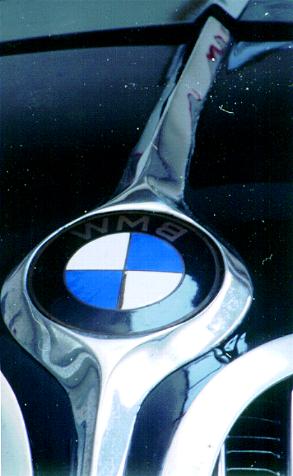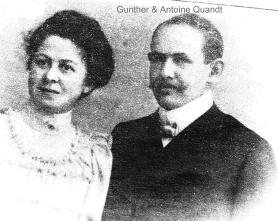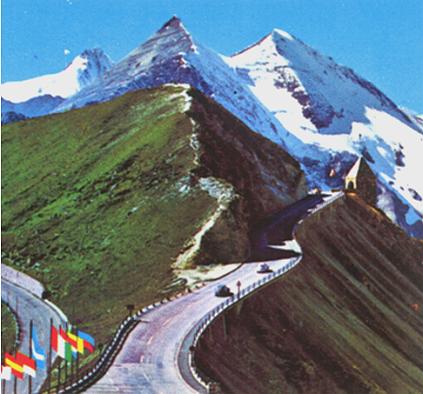While Grossglockner is normally closed from November through April (hours are usually 5AM
to 10PM), by June most of the snow has melted on the barren upper slopes. For information on the
Hochalpenstrasse, write: Grossglockner Hochalpenstrassen AG, Rainerstrasse 2, 5020 Salzburg.
For road conditions call 04824/2606.
Hinterbruhl bei Modling 20 km SW of Vienna.
Seegrotte This, Europe's largest subterranean lake, was one site used to build Heinkel
aircraft, including the He 162 Salamander or "Volksjager" ("People's fighter") in 1944. The
He 162 was powered by BMW 003E-1 or E-2 Orkan single shaft turbojets. The BMW jet drove an
alternator and hydraulic pump to operate the flaps and landing gear.
Germany
Aalen
Swabian Iron & Steel Works In Aalen-Wasseralfingen, this firm built three aluminum, Wunibald
Kamm-designed 20 PS front wheel drive cars, the SHW, with a BMW M2B15 engine. The car, BMW’s attempt at a
VW, did not meet design expectations and was scrapped in 1928.
Aldershof
Berlin suburb. Site of the German Experimental Station for Aeronautical Research ca. 1933. Here Hanna
Reitsch tested air brakes on a Sperber glider. Max Friz achieved high altitude records from the military airfield
here using his BMW IIIa engine in an Albatros DVa fighter in early 1918. While BMW was given a contract for 200
engines, Opel was funded to build 700 more under liscense. Today Aldershof is home to a science park for nuclear,
applied chemistry and other research.
Allach
BMW / MAN Factory In 1936, under pressure from the Reich Aircraft Ministry, BMW built a camouflaged
plant in Allach, on the north edge of Allach. Initially, the Reichs Works, as Popp called them, were used to test
BMW 132 engines which were brought to and from Milbertshofen (Munich) on low loaders. By 1944 there were as many
as 20,000 workers at Allach, including 3000 POWs and up to 5000 concentration camp inmates, many from nearby
Dachau, producing 14 cylinder, 2000 HP radial aircraft engines (BMW 801's) throughout WW II. BMW's attempt at jet
engine design was less than successful as most German jets were powered by Junkers Jumo turbines.
By 1944, Helmut Zuhlsdorf moved his rocket research effort to Allach. In addition a rocket group headed by
Austrian SS Lieut.
 Helmut Zborowski used a separate section of the facility for new weapon research.
Helmut Zborowski used a separate section of the facility for new weapon research.
In 1944 or 1945, the Zühlsdorf rocket facility was moved to Bruckmühl near Rosenheim. After the war, Zborowski
was taken by the French to do research at a chateau near Paris, then brought back to Bonn.
Alfred Böning, a BMW motorcycle design engineer under Schleicher, was transferred to Allach during the war, then
back to Milbertshofen as the Americans arrived.
After the war, BMW's "shadow factory" was only partly dismantled as the Allies used it as a vehicle maintenance
facility under the 143rd Ordnance Base Automotive Battalion directed by Schorsch Meier and renamed the Karlsfeld Ordnance
Depot. Most of the trees were cut down.
But just after the war, Allach work on US Army vehicles was all that kept BMW’s Milbertshofen operation afloat. Dorls
was works manager here at the time. In 1950, over 7000 worked here, but the Army intended to leave by April, 1951. In
1955, BMW restarted Allach as BMW Triebwerkbau building GE turbines for F-104 Starfighter aircraft but Managing BMW Director
Richter-Brohm sold, that year, half the business to MAN who built vehicles there. In May, 1960, BMW chief shareholder Herbert
Quandt and Semler sold the rest, along with a Starfighter (designed in 1952 by Kelly Johnson) jet engine contract, to MAN.
In 1965 BMW sold the rest of its shares in Power Plant Production Co. Ltd (Triebwerkbau GmbH) to MAN AG which renamed the
firm MAN Turbo GmbH which was merged with MAN Turbomotoren GmbH. MAN had facilities in Berlin-Spandau, which built Rolls
Royce Tyne engines under liscense, and in Friedrichshafen.
Aschaffenburg Aschaffenburg, an attractive city on the Main river 40 km
east of Frankfurt, supported a large US military community during the cold war.
Collection Rosso Bianco Obernauer Straße 125, 4 km from Autobahn exit Aschaffenburg West. Museum of over 200 cars
including the world's largest collection of Alfa Romeo race cars, the world's largest collection of MacLaren, Les and Zagato
cars and the largest Ferrari collection in Europe. There are also Porsches, a 1950 Daimler Special Sports, 1956 Mercedes 300 SL
and 1955 300 SLS, a 1929 Bugatti type 43 and a 1938 Lancia Astura MM built for Mussolini's son. BMWs include a 1980 M1 and a
1938 328 (photo, right). Open year round except Mondays, 10 to 6. Entrance fee: 10 DM.

Babelsburg Near Potsdam, Babelsburg lies along the Jungfernsee portion of the
Havel. Here, Magda and Günther Quandt, whose son Herbert would later acquire BMW, had a 10 room villa in 1921, after their marriage
in Bad Godesberg. The villa was not attractive, but had a nice garden sloping to the water where stood a boat house and luxurous
motor boat.
Magda took care of Quandt’s two sons but found Günther to be unsociable, jealous and materialistic. Magda had a son, Harold,
on 1 November, 1921 with no delivery problems. When a trade official, Schulze, was killed in an accident, Quandt took on the man’s
three children, now a total of six for Magda to deal with. About 1923, Quandt, using the depression to his advantage, purchased another
property on Frankenallee, near Reichskanzlerplatz. The Babelsburg villa was used on
weekends and during the summer.
Bad Godesberg On the Rhine SW of Bonn. Rheinhotel Dressen
Rhinehotel Dreesen, located directly on the Rhine and on Rheinaustraße 1 is still owned by the Dressen family, as it has been since its
opening in 1894. During the 1920s, this hotel along the Rhine was run by Frau Dreesen who was friendly with Hitler after Hess, who had
gone to school in the area, recommended the hotel to him. Not forgetting her kindness, Hitler preferred to stay at the Dressen when in
the area after he came to power.
In 1929, Magda Quandt and her student lover stayed here, though the liasion was known by Günther Quandt who had her leave their
house in Berlin. The Qunadts separated in the summer of 1929.
Mannheim
Mercedes Benz Factory Mannheim - Luzenhof and Waldhof, N of city center. Presently building
trucks and buses, this plant attracted Hitler who often inspected the plant. In 1886, Benz employed
40 men who built 12 cars on Waldhofstrasse. By 1888, Benz was selling cars to Emile Roger in Paris.
In 1891, Benz built his first four wheel car, the Viktoria, on Waldhofstrasse. In 1893, Benz
distributors established themselves in New York City and Benz introduced the Vis-a-Vis.
In July, 1894, Austrian industrialist Theodor von Liebieg drove a car on a long distance (939 km)
trip for the first time. He left Reichenberg, Bohemia and drove to Reims, France and back, via
Mannheim, in July, 1894.
Though Benz introduced the Velo, a 12 mph car that became the world's first mass-produced car, Benz
began losing market to Daimler. Benz sales manager Julias Ganss had a French team build the Parzifal
based on shaft-driven Renault designs. The conflict between Benz and Ganss caused Carl to resign. With
Parsifal sales slipping, Ganss resigned along with his French engineering team. Benz returned in 1904,
redesigned the Parsifal, and rescued his failing company. In 1906, Benz left Mannheim for Ladenburg.
In 1909, the year a 200 HP Blitzen-Benz set a speed record of 127.3 mph at Brooklands, England, Benz
AG bought 300,000 square meters in Waldhof-Mannheim, near the train depot at Luzenburg but WW I would
bring Benz to its knees and transfer of power to an Asian entrepreneur.
Jakob Shapiro, a Jewish emigrant (born Odessa, 1885) and Berlin auto dealer, took control of Benz,
including the facility in Mannheim, during the inflationary period of 1922-25. He did so by acquiring
SCHEBERA, a company that made car bodies for Benz in Berlin, in 1919. Shapiro had gone from Russia to
Vienna, then to Berlin where he began by starting a driving school, then obtaining a Benz dealership.
Shapiro bought cars from Benz on credit and controlled the supply of bodies to Benz, but Shapiro
would not pay Benz for cars until inflation allowed him to pay in cheap marks while selling the cars
for higher valued marks, i.e., customers would, as they often do today in Germany, pay for the car
before it was made. Shapiro used his profits to buy up 40% of Benz's stock.
Shapiro, a great target for Hitler, also made money by producing a less expensive, less well made
product. According to Daimler Benz racing chief Alfred Neubauer in "Men, Women and Cars", Shapiro
bought chassis from Benz and had them bodied at his shop in Berlin. "Suddenly finished cars appeared
on the market which were 3000 marks cheaper than similarly-sized vehicles from established companies.
From the outside you could not tell that they were fitted inside with cheap, poor quality panels.
Shapiro soon became the main shareholder and sole representative of Benz."
"Herr Neubauer," Shapiro, standing in front of his 4 liter Benz in a morning coat, bowler hat and
fat cigar, said at a Berlin Motor Show, "I’d like to see anyone do what I’ve done: come to Berlin with
just a few pairs of braces and end up owning Benz & Co. like me!"
Shapiro used his profits from Benz to, in 1920, acquire Fahrzeugfabrik Eisenach, merging it with
Gothaer Waggonfabrik in 1921. On 14 November, 1928, Popp and Castiglioni acquired the Eisenach facility,
later using it to produce the first BMW cars.
Shapiro, along with Hugo Stinnes (died 1924), whose family helped finance Hitler, and Jakob
Goldschmidt of Darmstadtler and National Bank, hoped to take over Germany's entire auto industry. The
scheme would have succeeded had not Daimler and Benz, helped by Emil von Strauss of Deutsche bank, merged
in 1925, cutting Shapiro's interest to 16%. Stauss had previously halted Shapiro, in 1923, when Shapiro
had tried to sell his Benz shares to Belgian banks.
But Shapiro was not quite finished with Daimler Benz. By 1928, he had affiliated his Gotha Railway
Carriage Company to Zyklon Works (Mylau), took a strong position at NSU and acquired Chillingworth Presser
and Extruder Works in Nürnberg. He had ca. 1927, also gotten on the board at BMW and Daimler-Benz.
The Daimler-Benz merger began producing the first Mercedes-Benz cars in 1927, with 2 liter passenger
cars being assembled in Mannheim; 4 and 6 liter units in Untertürkheim.
In 1930, Mannheim's car production shifted to Stuttgart while truck production was carried on at
Mannheim and Gaggenau. Meanwhile, the stock market crash of 1929 finished Shapiro who was soon facing a
Germany under Hitler. I have yet to find out the ultimate fate of Shapiro but Daimler Benz survived.
Though 20% of Daimler Benz's Mannheim factory was destroyed in
WW II, it was healthier than ever in 1988, producing trucks and heavy vehicles.
Pritzwalk NW of Berlin. Meyenburger Tor 6 The Quandts, so essential to the existance of today's BMW, were
descendents of a Dutch rope-making family. They settled in Wittstock and Pritzwalk, between Berlin and Schwerin, in the 1700s.
Günther Quandt, without whom his son Herbert would have been unable to acquire BMW, was born in Pritzwalk, on 28 July, 1881 to Emil Quandt who, along with his
father and grandfather, had made fortunes in this area in textiles. Günther’s brother Werner
married teenager Eleonore (Ello) ____ , who became Magda Goebbel’s best friend throughout her
life. Ello divorced Werner in ___ and was living in Munich in 1951.
Günther attended Pritzwalk Mittelschule in 1896, then Luisenstädtische Oberrealschule in
Berlin. In January, 1901, he began working for Friedrich Wilhelm Wegener in nearby Wittstock
an der Dosse, where he remained for 19 years while living in Pritzwalk.
Günther Quandt and his first wife, Antoine (‘Toni’, nee Ewald, see photo below) had two sons here. The first was Helmut, who died in 1927, and Herbert Werner, born on 22 June, 1910 at 7:30 AM and christened in Pritzwalk’s Nicolai-Kirche a few months later. Herbert was afflicted with a retinal disease that left scars, and he was nearly blind from age nine on.
 During WW I, the Quandts supplied the German army with uniforms, building up a fortune that Günther would use during the post war inflationary period to acquire AFA, a battery manufacturer in Hagen, Germany. The battery factory, which provided lead acid batteries to U-boats during WWII, would be Quandt’s main source of income and would create the fortune by which his son would eventually acquire BMW.
During WW I, the Quandts supplied the German army with uniforms, building up a fortune that Günther would use during the post war inflationary period to acquire AFA, a battery manufacturer in Hagen, Germany. The battery factory, which provided lead acid batteries to U-boats during WWII, would be Quandt’s main source of income and would create the fortune by which his son would eventually acquire BMW.
Herbert and Helmet left for Arndt Grammer School in Berlin - Dahlem in the spring of 1919 when Antoine died, probably in Pritzwalk. Instead of taking over a farm purchased for him in Parchim, Herbert followed his father into the world of industry.
By 1921, Günther had left Pritzwalk, acquiring a villa in Babelsburg, a Berlin suburb, for his second wife, Magda Friedländer (later Goebbels), who he had married on 4 January, 1921 in Bad Godesberg. Günther, who was head of AFA by 1923, spent most of the rest of life either in Hagen or Berlin or on business trips. As Pritzwalk, and Quandt property in Berlin, came under the Russians at the end of WW II, the Quandts moved west - both Günther and Herbert Quandt are buried in the Waldfriedhof in Bad Homburg, north of Frankfurt.
In 1996 Suzanne Klatten (Herbert’s daughter by Johanna Quandt) came to Pritzwalk and donated 5 million DM for a new children’s school "Herbert Quandt Schule"
Links
Ferdinand Porsche's Europe:
Adolf Hitler's Europe:
BMW Deutschland:
Momo (Wheels and Steering Wheels) Homepage:
Lauderdale BMW History Page:
alt.autos.bmw/ : BMW Newsgroup
Mercedes Benz, A European Travel Guide
BMW USA
BMW Car Club of America
BMW AG
Copyright 1998 Dennis A. Burnside burn@cybertours.com
,
This page has been visited  times.
times.


 Helmut Zborowski used a separate section of the facility for new weapon research.
Helmut Zborowski used a separate section of the facility for new weapon research.
During WW I, the Quandts supplied the German army with uniforms, building up a fortune that Günther would use during the post war inflationary period to acquire AFA, a battery manufacturer in Hagen, Germany. The battery factory, which provided lead acid batteries to U-boats during WWII, would be Quandt’s main source of income and would create the fortune by which his son would eventually acquire BMW.